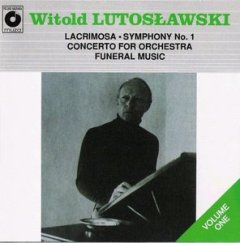Witold Lutoslawski: Lacrimosa - Concerto for Orchestra - First Symphony - Funeral Music (1989)
Witold Lutoslawski: Lacrimosa - Concerto for Orchestra - First Symphony - Funeral Music (1989)

I.- Lacrimosa*
II.- V.-Symphony Nº1+
VI.- VIII.- Concerto for Orchestra^
IX.- Funeral Music^
Stefania Woytowicz, soprano*
Polish Radio National Symphony Orchestra - Katowice*+
Witold Lutoslawski*
Jan Krenz+
National Philharmonic Orchestra - Warsaw^
Witold Rowicki^
Recorded: Katowice, 1988*, 1964+ and Warsaw 1962 & 1959(Funeral Music)
Concerto for Orchestra was written in the years 1950–54, on the initiative of the artistic director of the Warsaw Philharmonic, Witold Rowicki, to whom it is dedicated. It is written in three movements, lasts about 30 minutes, and constitutes the last stage and a crowning achievement of the folkloristic style in Lutosławski's work. That style, inspired by the music of the Kurpie region, went back in him to the pre-1939 years. Having written a series of small folkoristic pieces for various instruments and their combinations (piano, clarinet with piano, chamber ensemble, orchestra, human voice with orchestra), Lutosławski decided to use his experience of stylisation of Polish folklore in a bigger work. However, the Concerto for Orchestra differs from Lutosławski's earlier folkloristic pieces not only in that it is more extended, but also that what is retained from folklore is only melodic themes. The composer moulds them into a different reality, lending them new harmony, adding atonal counterpoints, turning them into neo-baroque forms.
Witold Lutosławski composed his First Symphony around the time of World War II, a conflict which impacted severely on his personal life and career. However, there are different ways of hearing this work in light of the circumstances surrounding its creation and Lutosławski's steadfast disavowal of his music's "extra-musical" content. Lutosławski's own opinion about the First Symphony's "meaning" differed quite radically from the views of his elderly audience member. The composer claimed to consider his work, "to be a rather serene piece, the finale at least should leave a person in such a mood." Ever the ardent formalist, especially where his own music was concerned, this disavowal comes as no surprise. ---ce-review.org
Funeral Music for strings is dedicated to the memory of Bela Bartók. Musique Funebre is a one-movement work made up of four linked sections: ‘Prologue’, ‘Metamorphosis’, ‘Apogeum’ and ‘Epilogue’. The first is constructed in the form of alternating canons based on a 12-tone row based exclusively on tritones and minor seconds. The ‘Metamorphosis’ builds up to a violent presto, while the ‘Apogeum’. The centre of the work leads to a central unison by contraction of the pitches used. The final ‘Epilogue’ begins fortissimo, after which the canons reappear until only a solo cello remains. Muzyka Żałobna (Musique Funebre) was written at the invitation of Jan Krenz in 1958 and first performed by the Great Symphony Orchestra of Polish Radio and Television conducted by Jan Krenz on 26 march 1958 in Katowice. ---musicsalesclassical.com
Lacrimosa for Soprano, Choir and Orchestra was created in 1937 as a part of a planned Requiem which was supposed to be Witold Lutosławski's thesis. He abandoned this thought quickly, and from the two remaining fragments (Requiem Aeternam and Lacrimosa) only Lacrimosa managed to survive through the war storm. It was composed according to the A-B-A scheme and in its musical sound it awakens clear associations with the later creativity of Szymanowski, particularly Stabat Mater: the a-minor key is dirtied with modalism through the appearance of the clear G-major triad on the 7th scale degree, the dominant is often minor. In the middle part the solo melody of the soprano is based on the homophonic texture of choir in which one can observe references to Romanticism and French influences, particularly Fauré's Requiem. The final Amen, sung and played by all the performers, closes the opus with an impressive phrase, dying in piano. The audience got to know both fragments of Requiem in the autumn of 1938. Just after the war, Polskie Wydawnictwo Muzyczne (PWM Edition) published Lacrimosa in a version for Voice and Organs and this specific arrangement was revived at the beginning of the 1980s, being frequently performed in Polish churches during the Martial Law period. The idea of a requiem, which as he said - every composer was writing for his funeral accompanied Lutosławski for a long time. He still thought about it in the 1970s, and because the traditional liturgical text as a whole didn't suit him, he consulted his cousin, a Benedictine, father Karol Meissner, a grandson of Wincenty Lutosławski, about possible changes. However, he never realised this idea. The music of Lacrimosa was to accompany him during his last journey in the cemetery chapel at Powązki. ---Krzysztof Meyer, musicsalesclassical.com
download: uploaded filecloudio anonfiles yandex 4shared mediafire solidfiles mega nornar
Zmieniony (Środa, 05 Luty 2014 16:27)








